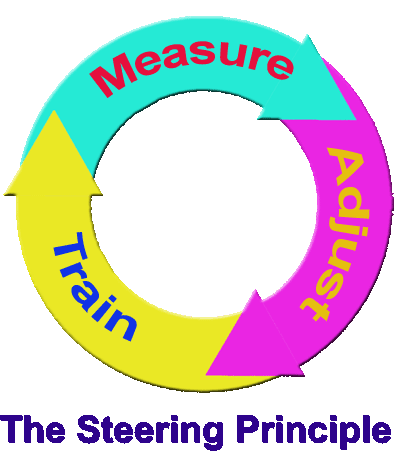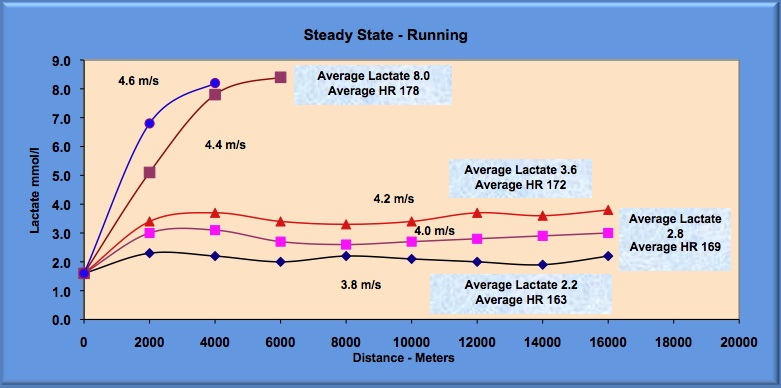Quote:
The fact that cannot be clearly articulated as to how it actually will help improve training practices means you'll have a real up hill battle trying to sell these things.
This is really only the second question addressed to me about this topic today. Nearly all the comments have been a pissing contest about something I am not sure what, I believe it is over my incompetence. So most of what I said today has not been an attempt to answer a specific question such as yours.
If one wants to get really good, one has to test or as we say measure. From the steering page on our website:
http://www.lactate.com/steering.html 
One can get better by just training as long as it is not too much and too strenuous. Nothing wrong with this as long as the athlete has no long range objectives to optimize performance. There are hundreds of books and websites today to provide training programs and advice. This is how most non elite athletes trained till about 20 years ago and how many if not most still train today. Often they will use feel and how fast or how easy they can complete a typical set to judge progress. But they will often reach a plateau in their competitions after initial success and maybe a little more intensity and volume will get them even better. Results in competitions are their measure of how well they are doing. And they keep track of similar workouts and compare with past results.
Testing - But many others will want to test more systematically along the way to see if they are progressing in their training. It could be very disappointing for someone to spend a lot of time training and then find out they are no better than their last competition or even worse. So one should test periodically to know that they are progressing and use measures that correlate with competition performance. One type of test to do this is some type of distance test. I am sure there are various types and I am not a triathlete or coach but have come across several different examples. You will know what they are much better than I. People seem to have their favorites.
One could also do a lactate test and and get the same feedback but maybe even better. Two lactate tests of 5-6 minutes each will provide similar information (e.g. the V4 - or pace that produces 4 mmol/l of lactate or P4 - the power that produces 4 mmol/l of lactate) to a 60 minute all out TT or any other distance test than one finds useful. This lactate test is a simple test that can gauge progress over the course of a training seasons and is used by many around the world. It does not require any motivation on the part of the athlete to complete and is over in about 12-15 minutes of sub maximal exercise.
So just for ease of compliance and speed of the test, the lactate test has its benefits. It does require a blood drop and for that reason many do not like it. But it is not expensive and two test strips will cost less than $5. One can purchase an analyzer for less than $300 (currently $280 for the cheapest one) so a coach can amortize it over several athletes. It is possible to add a couple stages to this simple test and look for inflection points to estimate what is known as the maximal lactate steady state. Some think this is necessary and such a test does provide additional information beyond a threshold estimate. But it is not necessary to set training paces.
Interpretation - But what does the power or pace mean whether it comes from the distance test or the lactate test?
What is behind this number. if one wants to train to make the number better next time. Would it not make sense to know what caused both the results of the distance test or the V4. We have a website on the "lactate threshold" and I have linked to it above. What does the LT mean, what causes it and how to train to improve it. One of the causes of the threshold is what is called anaerobic capacity. So when one gets a number from a distance test, one does not know what is the cause of that number. What combination of the aerobic and anaerobic system produced the number. A lactate test that attempts to get at the anaerobic component will help the coach estimate both the aerobic and anaerobic contribution and thus set more intelligent training objectives. This will require an additional short test and a couple more test strips so we are up to about $8 in supplies.
Examples- We once knew a triathlete who only wanted to be respectable in local meets. He competed for social reasons and could care less how he did as long as he did not stink up the place. He was actually quite talented but did not want to do the training to get better. He had a great V4, the speed which generated 4 mmol/l of lactate but his anaerobic capacity was off the charts. He generated 18 mmol/l in an all out test which meant his threshold was potentially much better if he would train to lower his anaerobic capacity. He just wanted to meet female triathletes and did enough training to do ok on weekend meets. There was another example Olbrecht told us about of a female that had a V4 equal to the world's best but never excelled in meets. He tested her on an all out test and all she could generate was some where between 4-5 mmol/l of lactate. She had a weak anaerobic capacity so any test of endurance such as a distance test or V4 would mis-lead the coach.
Now I realize that most are not familiar with the concept of including the anaerobic capacity in their training plans but if it is not considered it does not mean it isn't there and affecting both testing and performance. Since coaches are not used to this concept so they do not train to raise or lower it. And by doing so are not optimally training the athlete. Others are doing it instinctively.
Training- The other or main part of Olbrecht's approach is just how various training sets affect both aerobic and anaerobic capacity. Theoretically one does not need lactate testing to implement this but one is rolling the dice when one does. I met a swim coach who typed Olbrecht's book into his computer before there was an ebook. He could search for any concept he wanted to read about. He rearranged the book to suit his training approach and would classify every training set he gave his swimmers based on Olbrecht's classifications and implemented them based on Olbrecht's recommendations. He said he had good results and was on the fence whether to include lactate tests too to ensure he was doing it right or maybe to get it better. Only a couple of his swimmers were going to nationals and he wondered if he could make them even better.
Some people just want a system where they input a number and out pops a training plan. The question is what number you input and if it should be modified by something else. Then you train and measure again for the next training period. Hopefully, it works.
I apologize if this is not the most coherent explanation but the essence is,
performance is composed of many things and a very important one is the anaerobic capacity and how it interacts with the aerobic system, testing to get at the energy systems is best done with lactate testing, and finally training is based on training energy systems since this is what affects performance.
---------
Jerry Cosgrove
Sports Resource Group
http://www.lactate.com https://twitter.com/@LactatedotCom

